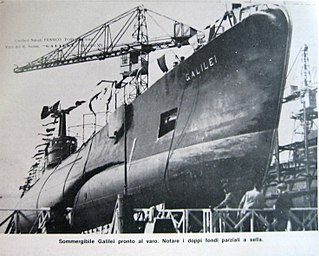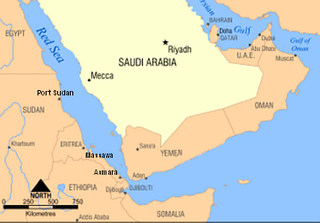German submarine U-464 was a Type XIV supply and replenishment U-boat ("Milchkuh") of Nazi Germany's Kriegsmarine during World War II.
HMT Cambridgeshire (FY142) was a British Second World War anti-submarine trawler of the British Royal Navy, named after Cambridgeshire, an English county.
HMT Warwick Deeping (H136) was a naval trawler of the British Royal Naval Patrol Service during World War II, sunk off the Isle of Wight in October 1940.
German submarine U-754 was a Type VIIC U-boat deployed by Nazi Germany's Kriegsmarine during the Second World War against allied shipping in the Atlantic Ocean. She was a successful but short-lived boat, sinking 13 ships during her career. She was most notorious for her final attack, in which she shelled and sank the small fishing vessel Ebb, and killed a number of its crew with machine-gun fire as they attempted to launch a life raft. She was sunk with all hands by a Royal Canadian Air Force bomber three days later on 31 July 1942.

Galileo Galilei was one of four Archimede-class submarines built for the Regia Marina during the early 1930s. She was named after Galileo Galilei, an Italian astronomer and engineer.

HMS Sportsman was a third-batch S-class submarine built for the Royal Navy during World War II. Completed in 1942, she spent most of the war serving in the Mediterranean Sea. After an initial patrol off Norway, she sank the heavy transport Général Bonaparte in the Mediterranean in 1943 and missed a French oil tanker. She was heavily damaged after a mistaken attack by an Allied bomber, and was sent east after repairs to participate in operations in the Black Sea. After the operation was cancelled, Sportsman patrolled the Aegean Sea, sending several Greek and German ships to the bottom. She sank the German transport SS Petrella in early 1944 despite it being clearly marked as a prisoner-of-war ship, killing 2,670 out of 3,173 Italians aboard. Sportsman sank several more ships, and suffered minor damage when she was detected and sighted while attempting to attack a convoy.

HMS Unrivalled (P45) was a U-class submarine built for the Royal Navy during World War II. The boat has been the only ship of the Royal Navy to ever bear the name Unrivalled. Completed in 1942, the boat spent most of the war in the Mediterranean. She sank a number of small merchant ships and naval auxiliaries, but major success eluded her during the war. Too small and slow for the post-war environment, Unrivalled was scrapped in 1946.

The Red Sea Flotilla was part of the Regia Marina Italia based at Massawa in the colony of Italian Eritrea, part of Italian East Africa. In World War II, the Red Sea Flotilla was active against the East Indies Station of the Royal Navy, from the Italian declaration of war on 10 June 1940 until the fall of Massawa on 8 April 1941.

HNoMS Honningsvåg was a naval trawler that served throughout the Second World War as a patrol boat in the Royal Norwegian Navy. She was launched at the North Sea harbour of Wesermünde in Hanover, Germany in February 1940 as the fishing trawler Malangen and was captured by Norwegian militiamen at the North Norwegian port of Honningsvåg during her maiden fishing journey to the Barents Sea. Having taken part in the defence of Norway in 1940 she spent the rest of the war years patrolling the ocean off Iceland. She was decommissioned in 1946, sold to a civilian fishing company in 1947 and scrapped in 1973.

German submarine U-558 was a Type VIIC U-boat in the service of Nazi Germany's Kriegsmarine during World War II. She sank 18 ships totalling 94,099 GRT before being sunk by bombers on 20 July 1943.
SM U-28 or U-XXVIII was a U-27-class U-boat or submarine for the Austro-Hungarian Navy. U-28, built by the Austrian firm of Cantiere Navale Triestino (CNT) at the Pola Navy Yard, was launched in January 1917 and commissioned in June.
SM U-32 or U-XXXII was a U-27 class U-boat or submarine for the Austro-Hungarian Navy. U-32, built by the Hungarian firm of Ganz Danubius at Fiume, was launched in May 1917 and commissioned in June.

A naval drifter is a boat built along the lines of a commercial fishing drifter but fitted out for naval purposes. The use of naval drifters is paralleled by the use of naval trawlers.

SM U-21 was a U-boat built for the Imperial German Navy shortly before World War I. The third of four Type U-19-class submarines, these were the first U-boats in German service to be equipped with diesel engines. U-21 was built between 1911 and October 1913 at the Kaiserliche Werft in Danzig. She was armed with four torpedo tubes and a single deck gun; a second gun was added during her career.

HMS Lady Shirley (T464), also known as HMT Lady Shirley, was a fishing trawler requisitioned by the Royal Navy in 1940 and converted for anti-submarine warfare duties. She sank U-111 on 4 October 1941, capturing 44 of her crew. Lady Shirley was sunk herself on 11 December 1941, by a single torpedo from U-374

The action of 15 August 1917 was a naval engagement which occurred during the First World War. The action was fought between a German U-boat and two naval trawlers, Nelson and Ethel & Millie, in the North Sea.
Armed trawler Nelson was a British auxiliary warship which served during World War I. She was built in 1905 as the fishing smack G&E, operating from Lowestoft and registered as LT 649. In 1915 she was armed for defence against U-boat attack, and fought several actions against them. She was sunk in action on 15 August 1917. This action was fought between a German U-boat and two trawlers, Nelson and Ethel & Millie, off the English coast.
The Armed trawler Ethel & Millie was a British auxiliary warship which served during World War I. She was built in 1908 as the fishing smack Ethel & Millie, operating from Lowestoft and registered as LT 200. In early 1917 she was armed for defence against U-boat attack, and fought two actions against them. She was sunk in action on 15 August 1917.
Guglielmotti was a Brin-class submarine built for the Royal Italian Navy during the 1930s.
Caldew was a British steam fishing trawler. Launched in 1914 as Maristo, she was requisitioned by the Royal Navy for service in the First World War the following year. Maristo survived the war and resumed trawling for the next two decades, being renamed Caldew in that time. She collided with fellow trawler Ospray II in 1935, sinking the latter ship.










